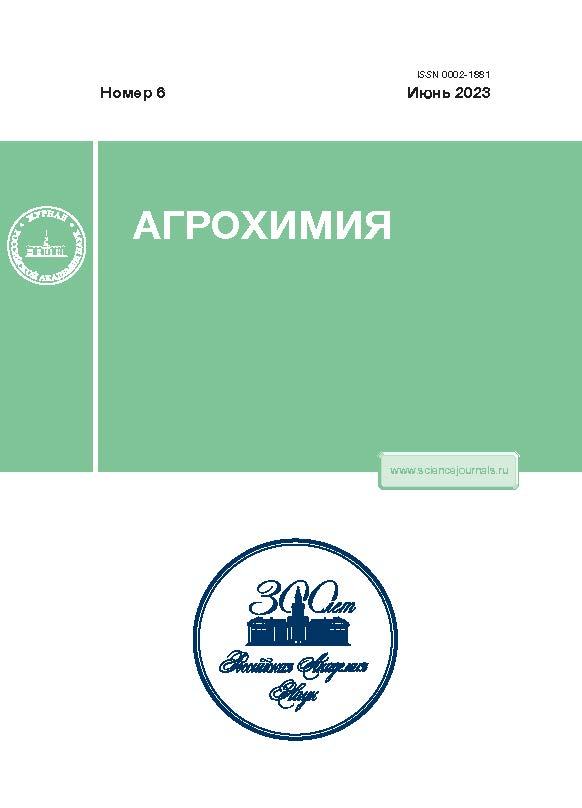ICP-OES-Analysis for Humic Substance
- Authors: Kolmykov R.P.1
-
Affiliations:
- Federal Research Center of Coal and Coal Chemistry SB RAS
- Issue: No 6 (2023)
- Pages: 73-80
- Section: Research Methods
- URL: https://journals.rcsi.science/0002-1881/article/view/139620
- DOI: https://doi.org/10.31857/S0002188123060091
- EDN: https://elibrary.ru/QOYAXJ
- ID: 139620
Cite item
Abstract
The possibilities of optical emission spectrometry with inductively coupled plasma (OES-ICP analysis) (in radial plasma observation) of humic preparations (HP) are evaluated, the proposed technique allows quantifying up to 24 elements (As, Al, B, Ba, Ca, Cd, Co, Cr, Cu, Fe, K, Mg, Mn, Mo, Na, Ni, P, Pb, Si, S, Sr, Ti, V and Zn). The list of these elements will allow determining the value of such preparations for soil nutrition, and will also help to avoid danger if the content of toxic impurities in them goes beyond their maximum permissible concentrations. In the absence of standard samples with certified contents of the elements to be determined, the correctness of the analysis for the macrocomponent composition is confirmed by comparing the results of gravimetric determination of the ash content of the studied objects with the calculated data obtained when processing the results of OES-ICP analysis. Systematic errors in the determination of trace impurities were minimized by using the method of adding standard solutions (from matrix influences), as well as 6 parallel measurements of samples prepared independently of each other. The correctness of the methodology was also evaluated by using model solutions close to the possible micro-impurity mineral composition of HP using the Student’s t-test. The results obtained for the isolated fraction of humic acids are compared with the literature data.
About the authors
R. P. Kolmykov
Federal Research Center of Coal and Coal Chemistry SB RAS
Email: kolmykoff.roman@yandex.ru
Russia, 650099, Kemerovo, prosp. Sovetskiy 18
References
- Enev V., Pospíšilová L., Klučáková M., Liptaj T., Doskočil L. Spectral characterization of selected humic substances // Soil Water Res. 2014. V. 9 (1). P. 9–17. https://doi.org/10.17221/39/2013-SWR
- Dudek M., Łabaz B., Bednik M., Medýnska-Juraszek A. Humic substances as indicator of degradation rate of chernozems in South-Eastern Poland // Agronomy. 2022. V. 12. P. 733. https://doi.org/10.3390/agronomy12030733
- Mellett T., Buck K.N. Spatial and temporal variability of trace metals (Fe, Cu, Mn, Zn, Co, Ni, Cd, Pb), iron and copper speciation, and electroactive Fe-binding humic substances in surface waters of the eastern Gulf of Mexico // Marine Chem. 2020. V. 227. 103891. https://doi.org/10.1016/j.marchem.2020.103891
- Bi D., Yuan G., Wei J., Xiao L., Feng L., Meng F., Wang J. A Soluble humic substance for the simultaneous removal of cadmium and arsenic from contaminated soils // Inter. J. Environ. Res. Public. Health. 2019. V. 16. 4999. https://doi.org/10.3390/ijerph16244999
- Peña-Méndez E.M., Havel J., Patočka J. Humic substances-compounds of still unknown structure: applications in agriculture, industry, environment, and biomedicine // J. Appl. Biomed. 2004. V. 3. P. 13–24. https://doi.org/10.32725/jab.2005.002
- Anuchina M.M., Pankratov D.A., Abroskin D.P., Kulikova N.A., Gabbasova D.T., Matorin D.N., Volkov D.S., Perminova I.V. Estimating the toxicity and biological availability for interaction products of metallic iron and humic substances // Moscow Univer. Soil Sci. Bul. 2019. V. 74. № 5. P. 193–198. https://doi.org/10.3103/S0147687419050028
- Ketris M.P., Yudovich Ya.E. Estimations of clarkes for carbonaceous biolithes: World averages for trace element contents in black shales and coals // Inter. J. Coal Geol. 2009. V. 78. P. 135–148. https://doi.org/10.1016/j.coal.2009.01.002
- Zhang S., Song J., Du Q., Cheng K., Yang F. Analog synthesis of artificial humic substances for efficient removal of mercury // Chemosphere. 2020. V. 250. 126606. https://doi.org/10.1016/j.chemosphere.2020.126606
- Radaelli M., Scalabrin E., Toscano G., Capodaglio G. High performance size exclusion chromatography-inductively coupled plasma-mass spectrometry to study the copper and cadmium complexation with humic acids // Molecules. 2019. V. 24 (17). P. 3201. https://doi.org/10.3390/molecules24173201
- de Melo B.A.G., Motta F.L., Andrade Santana M.H. Humic acids: Structural properties and multiple functionalities for novel technological developments // Mater. Sci. Engin. 2016. C. 62. P. 967–974. https://doi.org/10.1016/j.msec.2015.12.001
- Grigorieva E.E. About humic preparations // Inter. Agricult. J. 2020. V. 5. P. 43–58. https://doi.org/10.24411/2588-0209-2020-10210
- ГОСТ 55661-2013 Топливо твердое минеральное. Определение зольности. М.: Стандартинформ, 2014. 29 c.
- Xavier D.M., Silva A.S., Santos R.P., Mesko M.F., Costa S.N., Freire V.N., Cavada B.S., Martins J.L. Characterization of the coal humic acids from the Candiota coalfield, Brazil // Inter. J. Agricult. Sci. 2012. V. 4 (5). P. 238.
- Sarlaki E., Paghaleh A.S., Kianmehr M.H., Vakilian K.A. Chemical, spectral and morphological characterization of humic acids extracted and membrane purified from lignite // Chem. Technol. 2020. V. 14 (3). P. 353–361. https://doi.org/10.23939/chcht14.03.353
- He Z., Ohno T., Cade-Menun B.J., Erich S.M., Honeycutt W.C. Spectral and chemical characterization of phosphates associated with humic substances // Soil Sci. Soc. Am. J. 2006. V. 70. P. 1741–1751. https://doi.org/10.2136/sssaj2006.0030
- de la Rosa G., Peralta-Videa J.R., Gardea-Torresdey J.L. Utilization of ICP/OES for the determination of trace metal binding to different humic fractions // J. Hazard. Mater. 2003. B. 97. P. 207–218. https://doi.org/10.1016/S0304-3894(02)00262-5
Supplementary files









